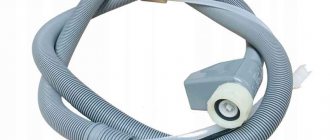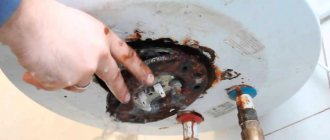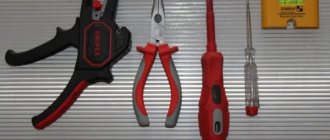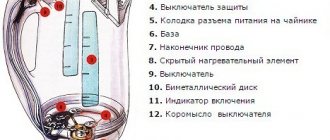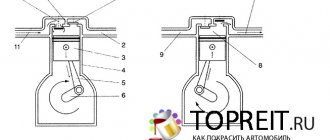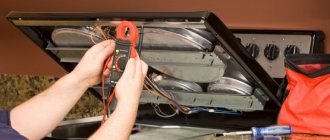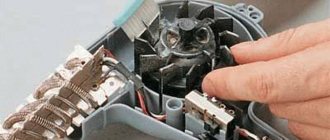4.9 / 5 ( 14 votes)
As usual, you put your dirty dishes in the dishwasher, turned them on and even selected a program, but the wash cycle did not start? In our article we will tell you what to do if the dishwasher does not work .
- Why won't my dishwasher turn on?
- Why is my dishwasher bad at washing dishes?
- Why does my dishwasher leak?
- How to fix the lock on a dishwasher?
Dishwasher device
Regardless of the brand and model, the design of the dishwasher is practically the same. The main nodes include:
- engine;
- circulation block;
- pump;
- pump;
- Control block;
- heating element (heating element);
- pressure switch;
- sensors;
- rocker;
Differences between models include optional features and additions. It could be:
- Heat exchanger. Allows you to dry dishes after washing. It looks like a container of water that gives off heat.
- Fan and additional heating element. Designed for drying dishes.
- Turbidity sensor. Measures the clarity of water after rinsing.
- Rinse aid and salt sensor.
- Water hardness sensor. Depending on the hardness value, the consumption of detergents is adjusted.
Causes of breakdowns and step-by-step instructions for eliminating them
You can deal with many problems that prevent water from filling into the dishwasher yourself.
Errors in connecting to the water supply
The system through which the dishwasher is connected to the water supply usually has a valve that allows you to turn off the water when necessary. It is placed on a pipe that is connected to the machine itself.
It is worth checking this tap - it may be closed or faulty:
Move the valve to a different position and try to turn on the water supply to the machine again.- Check that the tap is not difficult to rotate and is not leaking.
- When turning on the machine, check whether water flows through the pipe before and after the valve (noise, vibration of the pipe or hose indicate that water is passing through).
If a breakdown is identified, the valve must be replaced . To do this you need:
- shut off the water supply to the pipe leading to the dishwasher;
- remove the old valve and flush the pipe;
- install a new faucet and test it for leaks.
If water leaks out due to a defect, it will have to be replaced:
- First of all, you need to turn off the water supply to the dishwasher.
- Next, you need to remove the damaged hose and rinse the filter.
- Connect the machine through a new hose to the water supply, pre-wrap the connections with fum tape.
- Check the operation of the machine for leaks.
How the dishwasher works
To repair equipment, it is important to understand how it works. After dishes and detergents are loaded into the device, a program is selected and the start button is pressed, water is supplied . It is supplied through a valve to the water collection hopper using a pump. The water level is controlled by a pressure switch , which sends a signal when the intake is complete. Water under pressure enters the impeller, causing it to rotate. the compartment with detergent opens , and it mixes with jets of water gushing from the impeller nozzles.
Water is heated using a heating element, the heating temperature is controlled by a thermocouple. The water flows into the pan and re-enters the sprayer through the filter.
After the end of the program, the signal from the control unit is sent to the solenoid valve.
It shuts off the water supply to the sprinkler and allows access to drain it into the sewer. This starts the pump, pumping water out of the pan. Depending on the program, the cycle is repeated several times. At the end of the work, the water is finally drained and the drying mode . Drying occurs by condensation or by warm blowing on the dishes. After a while, the microprocessor of the device receives a signal indicating the end of the process and the door can be opened.
Additional elements that expand functions
To make working with PMM easier, most manufacturers improve the standard functions of the devices and add new ones. This is achieved by developing and installing additional components and elements in the PMM. You can find out about them from the seller or from the instructions.
Modern models are sometimes equipped with:
- Additional fan (cooler) and electric heater. They are designed for turbo drying mode so that the contents of the machine are drained very quickly.
- Sensor (sensor) for determining the contamination of a liquid. Based on the degree of water purity, it helps the household appliance to automatically select a function or program for washing. For example, it determines the temperature, consumption of detergent and liquid, their ratio (percentage of content), etc.
- Most newer models include salt sensors that alert you to the presence of rinse aid.
- Sensor Dry is only available in machines with a drying mode. It determines the temperature of the water and ambient air and selects the method (program) of drying the dishes. This sensor is installed only in very expensive models of washing machines.
- The mineral zeolite, poured into containers, greatly improves the drying of the enclosed items. The substance has properties necessary for washing. It quickly absorbs all moisture and in return produces heat.
- A sensor for monitoring liquid hardness is installed in expensive models. The readings of this sensor determine which washing program (method) the dishwasher processor will select.
- Expensive dishwashers have a green or red beam that appears on the floor. It indicates what stage the unit is going through and what action it is performing. On some models, this kind of indicator displays the end time of the process and the degree of completion of the program.
- Rocker designed specifically for baking trays.
- Holder (plastic or metal fork, hanger with slots) for glasses, glasses. Usually it is purchased separately, but some manufacturers have already put it on stream, and the holder is included in some new models.
“Dishwashers” are also divided by size, material of manufacture, number of rocker arms, and shape of baskets. In some machines, the baskets are adjusted vertically, in others - horizontally, in others they can even be folded.
Primary fault diagnosis
There are actually not that many malfunctions due to which the dishwasher does not work properly. They are known, and some of them resolve on their own. Very often, breakdowns are associated with the connection of communication devices or with irregularities in the operation of the device.
First of all, you need to make sure that the problem is in the machine itself. The water supply and drainage and the serviceability of the electrical network are checked. To do this, the dishwasher is disconnected from the communication systems, and their serviceability is checked independently of each other. If you suspect a breakdown of the device itself, pay attention to the following factors:
- The presence of extraneous sounds during operation. Most likely, the sprayer or pump bearings have failed. Incorrect loading of dishes.
- Water supply error. The outlet valve or supply hose will need to be replaced; the pressure switch is faulty.
- Stopping the program while running. There is a failure in the control system, you should repeat the launch on another program in a few minutes. Such a breakdown can also be caused by a malfunction of the filter, heating element, disturbances in water intake, or low voltage in the network.
- No heating. There is a high probability of failure of the temperature sensor or heating element, damage to the terminals of the heating element.
- The machine does not start. Damage to the electronics unit, no water supply, front door not closed.
- The device does not drain water. First of all, you need to check the sump pump and the hoses connected to it.
Problems can be caused by a lack of salt required to give the correct water hardness or the use of unsuitable detergents. Some users try to pour various gels used for manual washing into the detergent compartment.
For example, this is what happens if you put fairies in the dishwasher. When water is supplied, foam will begin to form due to the composition of the detergent. Since there are no defoamers, after a while there will be so much of it that it will fill all the components and parts of the dishwasher. In this case, the water inflow sensor will not be able to work normally and the indication of its absence will light up. The dishwasher will stop. You will need to open the machine and remove all removable structural elements, rinse the machine thoroughly with water and dry it thoroughly.
After that, you need to select a program without heating, since the foam is extinguished well in cold water. And run it several times. You can use vinegar or citric acid as a rinse aid, but remember the concentration. It should be weak, as it can have a detrimental effect on the rubber and plastic parts of the dishwasher.
Additional functionality of PMM
The basic configurations of dishwashers were discussed above. Inexpensive models from different manufacturers have approximately the same cost and functionality, so they differ little from each other.
But there are also premium class dishwashers that provide consumers with additional options.
Such devices may include the following non-standard components:
- Devices for drying dishes: additional heating elements, fans, heat exchangers, ventilation ducts.
- Automation to protect the control panel and door from children.
- Guide bars for convenient installation of baskets in the working chamber.
- Seamless control panels that look stylish and are easy to clean.
- Indicators of the remaining time until the end of the wash and the duration of each washing stage.
- Built-in water softener. It lasts quite a long time and is subject to regular regeneration.
- Additional tubes for connecting hot water directly from the water supply.
- A sensor system that detects the need to add softening salt to the water. Sometimes it works fully automatically in conjunction with a dosing device.
- 3-in-1 detergent unit, allowing you to install one cartridge with detergent, rinse aid and softening salt.
- Built-in heat exchangers that reduce temperature differences and increase the energy efficiency of PMM.
- Water purity sensor. It helps determine when rinsing is complete, saving time and energy.
- "Beam on the floor" system. It is a light indication projected onto the floor, allowing you to evaluate the current operating mode of the device.
- System for adjusting the height of baskets with dishes.
- A drying sensor that allows you to determine its optimal mode based on the characteristics of the external air.
Professional machines include most of the listed devices, which ensures high quality dish cleaning, energy efficiency and ease of use.
But you should understand that every additional part in the dishwasher increases its cost.
Why might the dishwasher stop and turn off?
There may be several reasons why a device may start and stop:
- the wrong washing mode has been selected,
- the machine does not take in water due to problems with its supply,
- if the machine turns off immediately after starting the program, there may be a problem with the socket or cord plug,
- the main pump is clogged with food debris or glass fragments,
- The thermostat has failed
- heating element burned out,
- operation is blocked by a broken float switch,
- The water sprayer is out of order (clogged with limescale),
- the inlet channel begins to become clogged.
The door is not closed
Symptoms: the characteristic click of the door closing was not heard; perhaps the corresponding indicator was on
Naturally, if the door is not closed, no sink will start. Check whether you have closed the door tightly: if visually everything is in order, inspect the lock. Read more about the causes of door problems and how to solve them in our article “The dishwasher door does not close.”
Prospects for proposed repairs
There are also cases when, after thoroughly cleaning the filters, the dishwasher refuses to work normally. To understand what kind of repair is needed, you must first find out what the problem is and what kind of breakdown occurred. To do this, it is important to understand which washing step was interrupted or skipped altogether.
If the operation of the dishwasher was suspended at any of these stages, then a breakdown occurred in the part responsible for this function or action.
Water circulation problems
The appliance has filled with water, but does not wash the dishes? It is important to understand how washing is carried out. The liquid is driven by a circulation pump through the heating element, after which it enters the spray nozzles. Through its nozzles, water flies under pressure into the chamber. By turning, the spray arms spray the liquid over the chamber and dishes.
Therefore, open the loading door and check the rocker arms. If their nozzles are clogged, then it’s clear why the equipment has stopped washing utensils. Remove the nozzles by pulling them towards you. Clean the holes with toothpicks and rinse with warm water.
If the PMM fills with water and does not work, the problem may be a problem with the circulation pump. You can replace the pump yourself, but it is better to entrust the inspection to a specialist. If the windings break, replacement is inevitable.
- Open access to the bottom.
- Remove the bottom panel.
- There is a pump in the center.
- Disable his contacts.
- Release the fastenings of the pipes and remove them.
- Replace the unit.
Water sprayer
This part can also be called a sprinkler, impeller or rocker arm . Most models have two of them - upper and lower, but some have one more - middle.
They are a plastic element similar to a propeller or helicopter blades, in which there are holes for supplying water under pressure. The most common problem with sprinklers is clogged nozzles.
They are easy to clean yourself:
First you need to remove the sprayer by unscrewing the fastening nut.- If you carefully examine the holes, you will notice that they are clogged with food particles or limescale. But it is also possible that at first glance there is no dirt.
- The next step is to place the inlet of the sprayer under running water. If there is no stream coming out of the nozzles or a weak one, it means they are clogged with something.
- Using a toothpick, carefully and thoroughly clean the nozzles and repeat the test with water. If the procedure is successful, the pressure should be the same from all holes.
In addition to clogged injectors, poor impeller rotation can be a problem. In this case, replacing the bearing may help.
Upper sprinkler gasket
This is a rubber circle that is located inside the fastening nut. Its wear can lead to water leakage and a decrease in its pressure; as a result, water will be drawn in more slowly, and the PMM simply will not start working.
The only thing that can be done in this case is to replace the gasket with a new one. How to do it:
- it is necessary to remove the sprayer and carefully remove the gasket from the nut;
- before installing a new one, you must carefully inspect the part for traces of food or other contaminants; mechanical particles prevent the parts from fitting tightly;
- Having inserted a new gasket, you need to reattach the sprayer to the PMM and check the operation of the device.
Drain filter clogged
Dishwasher manufacturers always indicate that all dishes must be cleared of large pieces of food before loading.
During the washing process, small particles along with water are drained into the lower part of the unit , where they are retained by the drainage filter. According to the instructions for most car models, it must be cleaned monthly.
Some companies provide the filter with a self-cleaning function. This allows you to lower your vigilance a little, but if suddenly the machine stops working for some unknown reason, it’s worth checking this part as well.
Grease, dirt, debris and scale can cause the water drain to be blocked and the PMM to refuse to wash dishes.
A worse scenario is that a faulty filter can allow particulate matter to enter the machine's internal components, causing more serious damage.
Instructions for action:
- The drain filter is located at the bottom of the washing chamber. It can be easily unscrewed from its socket.
- The part must be disassembled and washed thoroughly in warm water. You can use detergent and brushes to better clean the screens and small filter cells.
- If there is damage - cracks and chips, all that remains is to replace the part with a new one. Otherwise, dirt may get into the pump.
Pump impeller failure
The pump provides the required water pressure in the dishwasher.
Its malfunction leads to interruptions in the water supply, and as a result, a lack of washing dishes on the part of the PMM. The impeller is a rotating part, the failure of which causes water to leak or stop the pump . To get to it, first of all, you need to unscrew the bottom of the PMM.
To do this, the machine must be de-energized, disconnected from all wires and pipes and turned over on its side or “back” (rear wall).
When access to the bottom appears, it must be removed using a screwdriver. Next, you should carefully disconnect all the wires and pipes connecting the circulation pump to other parts of the machine. After this, you can begin to inspect the impeller.
The pump design may differ from one manufacturer to another . Despite the fact that the general principle of operation is the same, the nuances of fastening parts should be clarified in the instructions so that there are no problems with subsequent assembly.
Electronic prompts about the type of failure
Modern models are equipped with many sensors that control most processes. They are located on the inside of the body, near the valves, behind the walls and are sensitive to water level and temperature changes.
As soon as an emergency situation occurs, the sensors give a signal, the relay is activated and stops the washing process. The dishwasher's error code is displayed on the electronic display, which can be used to determine the reason for its stopping.
You cannot use the codes of one brand to determine breakdowns of another - the symbols differ for different manufacturers. They usually have alphanumeric designations
The list of codes can be found at the end of the instructions, in the repair section. It usually takes the form of a table, which contains the designations themselves, a list of breakdowns and recommendations for eliminating them.
Fragment of a table with Bosch SMV44IX model codes. The explanations from the last column help to cope with the problem without resorting to calling specialists
Sometimes self-diagnosis produces a code indicating several reasons at once - you will have to check the likelihood of all of them one by one. If the breakdown is serious, then in the table you can find the recommendation “contact service.”
In older models, especially those that have undergone more than one repair, the electronics often suffer and malfunctions occur.
If the machine obviously produces an incorrect code, you should have it repaired or think about buying a new one - kitchen appliances, like other appliances, have a limited service life.
We discussed popular breakdowns of dishwashers from well-known brands, error codes and methods for eliminating them in our following articles:
- Ariston Hotpoint dishwasher errors: error codes and how to resolve them
- Repair of Bosch dishwashers: decoding error codes, causes and troubleshooting
- Repair of Electrolux dishwashers at home: typical faults and their elimination
Prevention measures
In order to prevent a situation where half the program has passed and the washing suddenly stops, you need to remember several rules for operating the equipment:
- Place dishes cleaned of large food debris into the basket;
- Ensure the cleanliness of the coarse filter;
- Change the filling filter periodically;
- Wash the tank, blades and the entire machine from the inside;
- Clean the dishwasher from scale;
- Dry after each wash cycle.
In order to avoid problems with the operation of dishwashers, it is necessary to monitor their operation and carry out maintenance of the machine from time to time. This will take much less time than searching for the causes of the breakdown and its subsequent elimination.
Preventive Maintenance
Complex devices that combine mechanics and electronics cannot work forever, but it is possible to delay their breakdown. To do this, you need to follow the operating instructions and carry out preventive measures:
- Clean the drain filter and blades regularly;
- clean the door seal;
- remove visible dirt, mold, grease in a timely manner and prevent the appearance of rust;
- after the end of the cycle, wipe the dishwasher chamber;
- use a water softener;
- descale your car.
The electrical part of the machine is made reliably, but does not tolerate voltage surges; it is worth using a stabilizer.
The tablet did not dissolve
Another malfunction in the functioning of the dishwasher may be that the detergent does not dissolve in the collected water. This can be observed due to clogged nozzles or low water pressure in the system, due to which the liquid does not flow into the tray with the product. Remove the sprinklers and clean the elements thoroughly.
It is better to clean the injectors by pre-soaking them in a special soap solution.
The problem may also be associated with abnormal functioning of the dispenser opening mechanism, from which the detergent composition is washed out. If the valve does not start drawing liquid or does not completely stop it, the dishwasher tablet does not dissolve completely in the water. The solution to the problem will be to regulate the valve or completely replace it.
